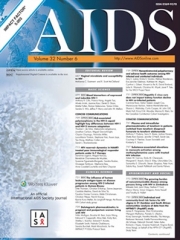Posted on November 13, 2016
Source: AIDS

Schrack, Jennifer A.; Jacobson, Lisa P.; Althoff, Keri N.; Erlandson, Kristine M.; Jamieson, Beth D.; Koletar, Susan L.; Phair, John; Brown, Todd T.; Margolick, Joseph B.for the Multicenter AIDS Cohort Study
Objective: Grip strength predicts functional decline and death, and is regarded as a biomarker of biological aging. The primary objective of this manuscript was to assess differences in the rate of decline in grip strength in persons aging with and without HIV.
Design: Grip strength was assessed in 1552 (716 HIV+ and 836 HIV−) men aged at least 50 years participating in the Multicenter AIDS Cohort Study between 2007 and 2014.
Methods: Grip strength decline was modeled longitudinally, adjusting for serostatus, demographics, comorbidities, and conditions. In HIV-specific models, coefficients were included for cumulative viral load and history of AIDS.
Results: Grip strength at the age of 50 years averaged 37.9 and 38.2 kg for HIV+ and HIV− men, respectively (P = 0.70). In fully adjusted models, grip strength declined 0.33 kg/year in HIV− men (P < 0.001) and 0.42 kg/year in HIV+ men (P = 0.01). In HIV-stratified models, higher cumulative viral load indicated greater strength decline (−0.884 kg for 3.1–4.0 log10 copies-years/ml and −1.077 kg for ≥4.1 log10 copies-years/ml) relative to men with consistently low viral load (≤3.0 log10 copies-years/ml). Adjusted Cox proportional hazard models revealed a 70% greater risk of clinically weak grip strength in HIV+ men (adjusted hazard ratio 1.70; 95% confidence interval, 1.22–2.40).
Conclusion: Grip strength decline is accelerated in HIV-infected men, which may contribute to decreased life expectancy and lower quality of life with aging. Greater cumulative viral load exposure appears to be an important driver of this decline and underscores the importance of early initiation of therapy.